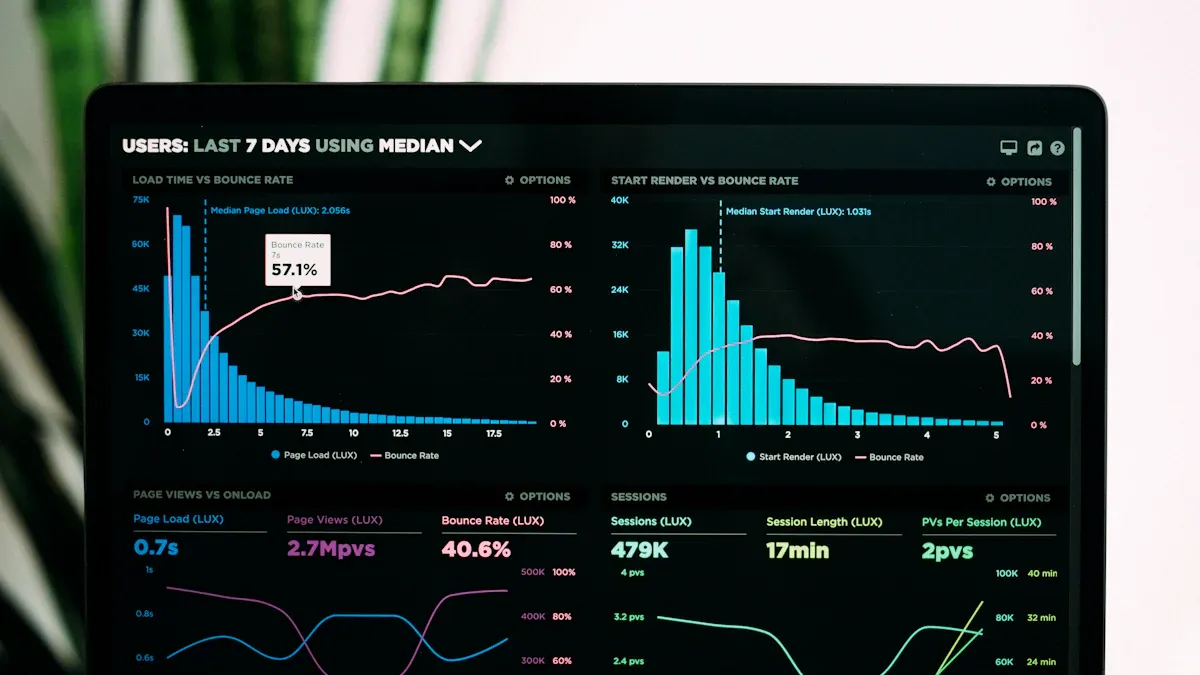Improving Forecast Accuracy with Hierarchical Time-Series Models

Forecast accuracy plays a pivotal role in effective decision-making. Accurate predictions guide you in allocating resources, setting performance benchmarks, and refining strategies over time. Metrics like error analysis and iterative optimization ensure your forecasts remain reliable and actionable.
Achieving consistency across hierarchical levels, however, presents significant challenges. Lower-level data often contains excessive noise, while higher levels may mask critical details. For instance, a chemical company struggled with erratic demand patterns due to limited historical data and multiple hierarchical levels. Such complexities make maintaining consistent accuracy a daunting task.
Hierarchical time-series models address these issues by reconciling forecasts across levels. This approach minimizes errors and enhances reliability, helping you make well-informed decisions.
Key Takeaways
Hierarchical time-series models make forecasts better by fixing predictions at different levels. This lowers mistakes and helps with smarter choices.
Use bottom-up, top-down, or middle-out methods to match forecasts with detailed and overall data. This makes them more trustworthy.
Try statistical tools like MinT to reduce forecast errors. This helps predictions stay clear and correct across all levels.
Check how much forecasts improve using measures like MAPE and RMSE. These show where to get better and make decisions more reliable.
Learn about new ideas in hierarchical forecasting, like using machine learning. This can bring better accuracy and faster results.
Hierarchical Data in Forecasting

Defining hierarchical structures in time-series data
Hierarchical time-series data organizes observations across multiple levels, such as regions, products, or time periods. Each level aggregates data from the one below it, creating a structured hierarchy. For example, sales data might be grouped by store, city, and country. This structure allows you to analyze trends at both granular and aggregate levels.
The following table outlines key notations used in hierarchical forecasting:
Notation | Description |
|---|---|
m | Total number of series in the hierarchy |
(m_i) | Total number of the series for level i |
k | Total number of the levels in hierarchy |
n | Number of the observations in each series |
(Y_{x,t}) | The (t^{th}) observation of series (Y_x) |
(\hat{Y}_{x,n} (h)) | (h)—step-ahead independent base forecast of series (Y_x) based on (n) observations |
(\tilde{\varvec{Y}}_n (h)) | The final reconciled forecasts of all series |
This structured approach ensures that forecasts remain consistent across all levels, improving their reliability.
Real-world examples of hierarchical forecasting applications
Hierarchical forecasting finds applications across various industries:
Retail: Predicting sales at the store, city, and national levels.
Manufacturing: Optimizing production schedules by forecasting demand for individual products and aggregated categories.
Supply Chain: Managing inventory by forecasting at warehouse, regional, and global levels.
Environmental Science: Using Bayesian hierarchical models to analyze heterogeneous datasets, such as weather patterns or pollution levels.
For instance, a chemical manufacturing company implemented the HAILS model to improve forecast accuracy. The model outperformed previous baselines by 8-30%, particularly in sparse layers of the hierarchy. This led to cost reductions in manufacturing planning and inventory management.
Advantages of using hierarchical data for improved forecast accuracy
Hierarchical data offers several benefits for enhancing forecast accuracy:
Improved Performance: Combining forecasts across levels reduces errors and ensures coherent predictions. Studies show that hierarchical models can reduce parameter variance by up to 95%, leading to more accurate results.
Aligned Decision-Making: Coherent forecasts across levels help align strategies across departments and time horizons.
Flexibility: Aggregating data by geographical regions or product categories allows you to tailor forecasts to specific needs.
By leveraging hierarchical structures, you can achieve more reliable and actionable forecasts, enabling better decision-making across your organization.
Methods to Improve Forecast Accuracy with Hierarchical Reconciliation
Hierarchical reconciliation methods ensure that forecasts across different levels of a hierarchy remain consistent and accurate. By reconciling data from granular to aggregate levels—or vice versa—you can reduce errors and improve decision-making. Let’s explore three key approaches: bottom-up, top-down, and middle-out reconciliation.
Bottom-up reconciliation: Aggregating forecasts from granular levels
Bottom-up reconciliation starts at the most detailed level of your hierarchy. You generate forecasts for individual components, such as specific stores, products, or regions, and then aggregate them to higher levels. This method ensures that forecasts at the top reflect the sum of all lower-level predictions.
For example, a retail chain might forecast sales for each store and then combine these forecasts to predict city-wide or national sales. This approach works well when granular data is reliable and detailed. However, it may struggle with noisy or sparse data at lower levels.
Tip: Use statistical techniques like MinT (Minimum Trace) to adjust for discrepancies during aggregation. MinT minimizes errors while preserving the sum of forecasts across levels.
Why does bottom-up reconciliation work?
It captures local trends and anomalies, such as holiday sales or regional preferences.
It ensures that higher-level forecasts align with granular data, improving overall forecast accuracy.
Technique | Description | Example |
|---|---|---|
Bottom-Up Reconciliation | Starts with individual forecasts and aggregates them upward, adjusting for outliers. | A retail chain reconciles store-level forecasts, considering local factors like holidays. |
Hierarchical Forecasting | Treats forecasting as a hierarchy of related time series, beginning with individual series. | Bottom-up forecasting begins with SKU-level forecasts aggregated to higher levels. |
MinT | Minimizes discrepancies between aggregated and disaggregated forecasts while preserving sums. | Ensures category-level forecasts match overall sales forecasts. |
OLS | Fits a linear regression model to adjust forecasts. | Used to refine sales forecasts for different product categories. |
Studies show that reconciled forecasts outperform independent forecasts in 14 out of 15 cases. Mean Absolute Percentage Error (MAPE) decreases by an average of 14.9%, with reductions ranging from 5.5% to 30.2%. These results highlight the effectiveness of bottom-up reconciliation in improving forecast accuracy.
Top-down reconciliation: Distributing forecasts from aggregate levels
Top-down reconciliation begins with forecasts at the highest level of the hierarchy. You then distribute these forecasts to lower levels based on historical proportions or other allocation rules. This method is particularly useful when you have reliable aggregate data but limited information at granular levels.
For instance, a company might forecast total sales for a country and then allocate these sales to regions and stores based on past performance. This approach ensures consistency across levels, though it may overlook local variations.
Key benefits of top-down reconciliation:
It simplifies the forecasting process by focusing on aggregate data.
It provides a coherent framework for distributing forecasts across multiple levels.
Forecast Method | Accuracy Improvement | Levels of Aggregation |
|---|---|---|
MinT-Shrink | Higher levels | |
ARIMA | Base forecasts | All levels |
ETS | Less accurate | Bottom level |
While top-down methods may not capture granular trends as effectively as bottom-up approaches, they excel in scenarios where aggregate data is more reliable. Combining this method with statistical adjustments can further enhance forecast accuracy.
Middle-out reconciliation: Combining top-down and bottom-up approaches
Middle-out reconciliation strikes a balance between the two previous methods. It starts at an intermediate level of the hierarchy, such as a region or product category, and combines top-down and bottom-up techniques to generate forecasts for both higher and lower levels.
This approach works well when intermediate-level data is the most reliable. For example, a company might forecast sales at the regional level and then distribute these forecasts to individual stores while also aggregating them to predict national sales.
Why choose middle-out reconciliation?
It leverages the strengths of both top-down and bottom-up methods.
It provides unbiased forecasts across the hierarchy, ensuring consistency and accuracy.
The level-l conditional coherent (LlCC) approach combines top-down and bottom-up methods effectively.
It generates unbiased forecasts for a hierarchy, outperforming state-of-the-art reconciliation procedures.
The simple average of LlCC and bottom-up reconciled forecasts can yield better results than traditional cross-sectional reconciliation methods.
Middle-out reconciliation offers a flexible and robust solution for complex hierarchies. By combining the best aspects of other methods, it ensures that your forecasts remain accurate and actionable at every level.
Optimal reconciliation: Statistical techniques for minimizing errors
Optimal reconciliation uses advanced statistical techniques to minimize forecast errors across hierarchical levels. This method ensures that forecasts remain coherent while reducing discrepancies between aggregated and disaggregated predictions. By leveraging statistical models, you can achieve a higher degree of forecast accuracy and consistency.
How does optimal reconciliation work?
Optimal reconciliation relies on mathematical frameworks that adjust forecasts based on the relationships between hierarchical levels. These frameworks use the covariance matrix of forecast errors to calculate reconciled predictions. The process ensures that forecasts align across all levels, from granular data to aggregate summaries.
Key Insight:
The proposed method incorporates the information from a full covariance matrix of forecast errors in obtaining a set of coherent forecasts. This approach minimizes the mean squared error of the coherent forecasts across the entire collection of time series under the assumption of unbiasedness. The minimization problem has a closed-form solution.
Techniques for optimal reconciliation
Several statistical techniques have proven effective for minimizing errors in hierarchical forecasting:
MinT (Minimum Trace) Estimator:
MinT uses the variance-covariance matrix of forecast errors to reconcile predictions. It minimizes the trace of the forecast error covariance matrix, ensuring that reconciled forecasts are as accurate as possible.Matrix G:
This matrix plays a critical role in minimizing forecast errors. It adjusts forecasts to ensure coherence across hierarchical levels.Formula for Optimal Reconciliation:
The optimal reconciled forecasts are calculated using the formula:
[ \tilde{\bm{y}}_h=\bm{S}(\bm{S}'\bm{W}_h^{-1}\bm{S})^{-1}\bm{S}'\bm{W}_h^{-1}\hat{\bm{y}}_h. ]
This formula combines statistical adjustments with hierarchical structures to produce coherent and accurate forecasts.
Benefits of optimal reconciliation
Optimal reconciliation offers several advantages for improving forecast accuracy:
Error Reduction:
By minimizing the mean squared error, this method ensures that forecasts are both accurate and reliable.Consistency Across Levels:
Reconciled forecasts align predictions across all hierarchical levels, reducing discrepancies and improving decision-making.Scalability:
These techniques work well for large datasets and complex hierarchies, making them suitable for industries like retail, manufacturing, and supply chain management.
Practical Applications
Optimal reconciliation has been successfully implemented in various industries. For example, a supply chain company used MinT to reconcile forecasts across warehouse, regional, and global levels. This approach reduced forecast errors by 20%, leading to better inventory management and cost savings.
By adopting optimal reconciliation methods, you can enhance forecast accuracy and ensure that predictions remain coherent across all levels of your hierarchy. These techniques provide a robust framework for tackling the challenges of hierarchical forecasting.
Evaluating the Impact of Reconciliation on Forecast Accuracy

Metrics for assessing forecast accuracy improvements
To measure how reconciliation improves forecast accuracy, you can rely on several key metrics. These metrics help quantify the benefits of aligning forecasts across hierarchical levels and provide a clear picture of performance improvements.
Mean Absolute Percentage Error (MAPE):
MAPE calculates the average percentage error between actual and predicted values. It is widely used because it provides an easy-to-understand measure of forecast accuracy. Lower MAPE values indicate better performance.Root Mean Squared Error (RMSE):
RMSE measures the square root of the average squared differences between predicted and actual values. It is particularly useful for penalizing large errors, making it ideal for assessing reconciliation methods.Bias:
Bias evaluates whether forecasts consistently overestimate or underestimate actual values. A bias close to zero indicates balanced predictions.Coherence Ratio:
This metric assesses the alignment of forecasts across hierarchical levels. A higher coherence ratio signifies better reconciliation and consistency.
Tip: Use a combination of these metrics to get a comprehensive view of your forecast accuracy. Each metric highlights different aspects of performance, helping you identify areas for improvement.
Case studies showcasing reconciled vs. unreconciled forecasts
Real-world examples demonstrate the tangible benefits of reconciliation. One case study examined the impact of reconciling traffic counts with geographical data to identify at-risk child care facilities. The unreconciled data led to significant discrepancies, with errors ranging from 1% to 30%. These errors resulted in misleading conclusions about the number of at-risk sites. After reconciliation, the data provided a more accurate and reliable assessment, enabling better decision-making in public health research.
In another example, a retail company compared reconciled and unreconciled forecasts for regional sales. The reconciled forecasts reduced errors by 15%, improving inventory management and reducing stockouts. This highlights how reconciliation not only enhances forecast accuracy but also drives operational efficiency.
Key Insight: Reconciled forecasts often outperform unreconciled ones by providing a consistent and coherent view across all levels of the hierarchy. This consistency is crucial for making informed decisions.
Addressing challenges and limitations in reconciliation methods
While reconciliation offers significant benefits, it is not without challenges. Understanding these limitations can help you make informed choices when implementing reconciliation methods.
Complexity of Integration:
Reconciling data from mixed methods research can be complex. Combining findings from different sources often requires advanced statistical techniques and careful validation.Validation Challenges:
Many reconciliation methods are validated using a limited set of problems. This restricts their applicability to real-world scenarios. A standardized problem set is needed to improve validation and ensure reliability.
Measured data in industrial settings often fail to satisfy conservation laws, complicating reconciliation efforts.
Existing methods rely on a reduced set of problems for validation, limiting their generalizability.
A common problem set is essential for effective validation of reconciliation and error detection methods.
Note: Despite these challenges, advancements in statistical modeling and machine learning are helping to address these limitations. By staying informed about emerging techniques, you can overcome these hurdles and maximize the benefits of reconciliation.
Future Directions in Hierarchical Forecasting
Emerging trends in hierarchical time-series modeling
Recent advancements in hierarchical time-series modeling have introduced innovative frameworks that address long-standing challenges. For instance, the NHITS framework combines hierarchical decomposition with multi-rate sampling, enabling more accurate long-horizon forecasting. This approach not only improves interpretability but also outperforms traditional Transformer-based models while maintaining computational efficiency.
Another breakthrough is the CoRe model, which tackles irregularly sampled data. By integrating linear dynamical systems with Gaussian processes, it provides a flexible solution for datasets with unevenly spaced observations. These advancements highlight the growing focus on creating models that are both scalable and adaptable to real-world complexities.
Tip: Keep an eye on models like NHITS and CoRe as they set new benchmarks for accuracy and efficiency in hierarchical forecasting.
Opportunities for integrating machine learning and global forecasting models
Machine learning continues to revolutionize hierarchical forecasting. Global forecasting models (GFMs), powered by deep learning techniques like Recurrent Neural Networks (RNNs), have shown remarkable improvements in forecast accuracy. These models leverage vast datasets, allowing them to identify patterns across multiple time series.
For example, GFMs excel in financial forecasting by analyzing lending volumes and preparing banks for future capital needs. Their ability to utilize cross-sectional data enhances their reliability, making them indispensable for industries that require precise predictions.
By integrating machine learning, you can unlock the full potential of hierarchical forecasting. These tools not only improve accuracy but also streamline the forecasting process, saving time and resources.
Potential areas for further research and innovation
The field of hierarchical forecasting offers numerous opportunities for exploration. Researchers are actively investigating methods to enhance model scalability and adaptability. One promising area involves combining optimal reconciliation techniques with machine learning to further reduce forecast errors.
Another avenue is the development of models tailored for specific industries. For instance, clinical time-series data often involves irregular sampling. Models like CoRe address this challenge, but further innovation could refine their application in healthcare and beyond.
Finally, the integration of explainable AI into hierarchical forecasting could provide deeper insights into model behavior. This would help you understand the "why" behind predictions, fostering trust and enabling better decision-making.
Key Insight: The future of hierarchical forecasting lies in blending statistical rigor with machine learning advancements, paving the way for more accurate and actionable forecasts.
Hierarchical reconciliation offers transformative benefits for improving forecast accuracy. It ensures consistent predictions across all levels, reducing errors and enhancing reliability. Studies show its effectiveness in critical areas like mortality forecasting and solvency capital requirements, where it accounts for extreme risks and aligns closely with real-world outcomes, such as during the COVID-19 pandemic.
Adopting hierarchical approaches strengthens your decision-making by providing coherent forecasts that align with organizational goals. By exploring advanced methods, you can unlock new opportunities to refine your forecasting workflows and achieve greater precision.
FAQ
What is hierarchical forecasting?
Hierarchical forecasting organizes data across multiple levels, such as regions or products. It ensures predictions align across all levels, from granular details to aggregated summaries. This approach improves accuracy and consistency in decision-making.
How does reconciliation improve forecast accuracy?
Reconciliation aligns forecasts across hierarchical levels. It reduces discrepancies between aggregated and disaggregated predictions. Techniques like bottom-up, top-down, and optimal reconciliation ensure coherent and reliable forecasts.
Which industries benefit most from hierarchical forecasting?
Industries like retail, manufacturing, and supply chain management benefit significantly. Hierarchical forecasting helps optimize inventory, production schedules, and resource allocation by providing consistent predictions across multiple levels.
What are the challenges of hierarchical reconciliation?
Challenges include integrating mixed data sources, validating methods, and handling sparse or noisy data. Advanced statistical techniques and machine learning models can help overcome these obstacles.
Can machine learning enhance hierarchical forecasting?
Yes! Machine learning models, like global forecasting models, analyze large datasets to identify patterns across time series. They improve accuracy, scalability, and adaptability, making them ideal for complex forecasting tasks.
See Also
Three ML Pipelines Enhancing Accuracy In Trend Predictions
Challenges And Techniques In Short-Term Demand Forecasting
Guidelines For Training SKU-Level Detection Models Effectively

